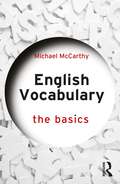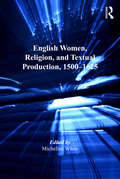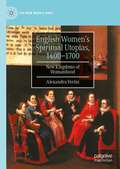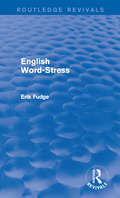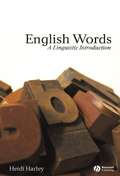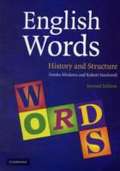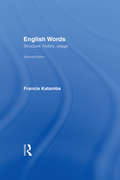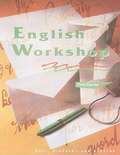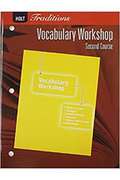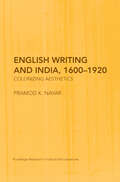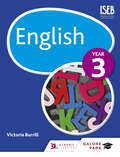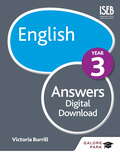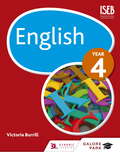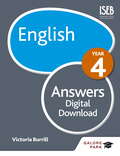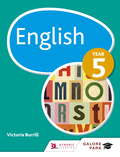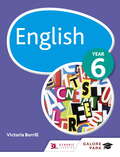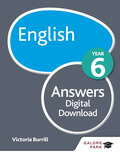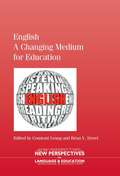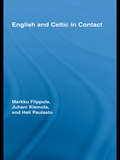- Table View
- List View
English Vocabulary: The Basics (The Basics)
by Michael McCarthyEnglish Vocabulary: The Basics offers a clear, non-jargonistic introduction to English vocabulary, the way linguists classify and explain it, and the place of vocabulary in our overall picture of the language, and in society. Introducing a range of terminology for discussing vocabulary, the reader is provided with a coherent, structured description of what we know about words and their meanings. Key features of this book include: • Analysis of historical roots of present-day words • Coverage of the differences between speech and writing and between formality and informality • Understanding of the social implications of choices that readers make to use standard or non-standard (e.g., regional/dialect) vocabulary • A focus on British English with reference to a wide range of varieties of English that include North American English, Irish English, Indian English, Malaysian English, Nigerian English and Caribbean English. Featuring a glossary of key terms, cartoons and illustrations, further reading, reflection points, interesting "factoids" and examples from corpora from around the world, this book is an engaging and thought-provoking read for anyone with an interest in English vocabulary.
English Women, Religion, and Textual Production, 1500-1625 (Women and Gender in the Early Modern World)
by Micheline WhiteContributing to the growing interest in early modern women and religion, this essay collection advances scholarship by introducing readers to recently recovered or little-studied texts and by offering new paradigms for the analysis of women's religious literary activities. Contributors underscore the fact that women had complex, multi-dimensional relationships to the religio-political order, acting as activists for specific causes but also departing from confessional norms in creative ways and engaging in intra-as well as extra-confessional conflict. The volume thus includes essays that reflect on the complex dynamics of religious culture itself and that illuminate the importance of women's engagement with Catholicism throughout the period. The collection also highlights the vitality of neglected intertextual genres such as prayers, meditations, and translations, and it focuses attention on diverse forms of textual production such as literary writing, patronage, epistolary exchanges, public reading, and epitaphs. Collectively, English Women, Religion, and Textual Production, 1500-1625 offers a comprehensive treatment of the historical, literary, and methodological issues preoccupying scholars of women and religious writing.
English Women’s Spiritual Utopias, 1400-1700: New Kingdoms of Womanhood (The\new Middle Ages Ser.)
by Alexandra VeriniEnglish Women’s Spiritual Utopias, 1400-1700: New Kingdoms of Womanhood uncovers a tradition of women’s utopianism that extends back to medieval women’s monasticism, overturning accounts of utopia that trace its origins solely to Thomas More. As enclosed spaces in which women wielded authority that was unavailable to them in the outside world, medieval and early modern convents were self-consciously engaged in reworking pre-existing cultural heritage to project desired proto-feminist futures. The utopianism developed within the English convent percolated outwards to unenclosed women's spiritual communities such as Mary Ward's Institute of the Blessed Virgin and the Ferrar family at Little Gidding. Convent-based utopianism further acted as an unrecognized influence on the first English women’s literary utopias by authors such as Margaret Cavendish and Mary Astell. Collectively, these female communities forged a mode of utopia that drew on the past to imagine new possibilities for themselves as well as for their larger religious and political communities. Tracking utopianism from the convent to the literary page over a period of 300 years, New Kingdoms writes a new history of medieval and early modern women’s intellectual work and expands the concept of utopia itself.
English Word-Stress (Routledge Revivals)
by Erik FudgeFirst published in 1984, this book was designed to benefit the foreign learner who wishes to grasp the essential basis of English stress so that he or she can go on to predict stress patterns in new words. It is aimed at teachers of English as a foreign language and helps them to communicate English stress effectively to their students. The book bridges the gap between books that are mainly anecdotal or abstract, practical or theoretical, or made up of lists or principles.
English Words and Sentences
by Eva Duran Eppler Gabriel OzónHands-on, theory-neutral and non-technical, this textbook is a basic introduction to the structure of English words and sentences. Assuming no prior knowledge of linguistic analysis, it presents the facts in a straightforward manner and offers a step-by-step guide from small to large building blocks of language. Every chapter contains numerous exercises and discussion questions, which provide essential self-study material, as well as in-chapter tasks which lead students to a more comprehensive understanding of linguistic issues. The book also features concise chapter summaries, suggestions for further reading, an inclusive glossary and two consolidation chapters which encourage students to secure their understanding of the English language. The dedicated companion website includes further exercises, answers and solutions to the exercises, as well as useful links.
English Words: A Linguistic Introduction (The Language Library #11)
by Heidi HarleyEnglish Words is a comprehensive and accessible introduction to the study of English words from a theoretically informed linguistic perspective. accessibly written to give students a command of basic theory, skills in analyzing English words, and the foundation needed for more advanced study in linguistic theory or lexicology covers basic introductory material and investigates the structure of English vocabulary introduces students to the technical study of words from relevant areas of linguistics: phonology, morphology, syntax, semantics, historical linguistics and psycholinguistics
English Words: History And Structure (Second Edition)
by Robert Stockwell Donka MinkovaThis new edition is concerned primarily with the learned vocabulary of English - the words borrowed from the classical languages. It surveys the historical events that define the layers of vocabulary in English, introduces some of the basic principles of linguistic analysis, and is a helpful manual for vocabulary discernment and enrichment. The new edition has been updated with a discussion of the most recent trends of blending and shortening associated with texting and other forms of electronic communication and includes a new classification of the types of allomorphy. It discusses important topics such as segment sonority and the historical shifting of long vowels in English, and includes a new section on Grimm's law, explaining some of the more obscure links between Germanic and Latinate cognates. Exercises accompany each chapter and an online workbook contains readings and exercises to strengthen knowledge acquired in the classroom.
English Words: Structure, History, Usage
by Francis KatambaHow do we find the right word for the job? Where does that word come from? Why do we spell it like that? And how do we know what it means?Words are all around us - we use them every day to communicate our joys, fears, hopes, opinions, wishes and demands - but we don't often think about them too deeply. In this highly accessible introduction to English words, the reader will discover what the study of words can tell them about the extraordinary richness and complexity of our daily vocabulary and about the nature of language in general.Assuming no prior knowledge of linguistics, the book covers a wide range of topics, including the structure of words, the meaning of words, how their spelling relates to pronunciation, how new words are manufactured or imported from other languages, and how the meaning of words changes with the passage of time. It also investigates how the mind deals with words by highlighting the amazing intellectual feat performed routinely when the right word is retrieved from the mental dictionary. This revised and expanded second edition brings the study of words right up to date with coverage of text messaging and email and includes new material on psycholinguistics and word meaning.With lively examples from a range of sources - encompassing poetry, jokes, journalism, advertising and clichés - and including practical exercises and a fully comprehensive glossary, English Words is an entertaining introduction to the study of words and will be of interest to anyone who uses them.
English Writing and India, 1600-1920: Colonizing Aesthetics (Routledge Research in Postcolonial Literatures #Vol. 18)
by Pramod K. NayarThis book explores the formations and configurations of British colonial discourse on India through a reading of prose narratives of the 1600-1920 period. Arguing that colonial discourse often relied on aesthetic devices in order to describe and assert a degree of narrative control over Indian landscape, Pramod Nayar demonstrates how aesthetics furnished a vocabulary and representational modes for the British to construct particular images of India. Looking specifically at the aesthetic modes of the marvellous, the monstrous, the sublime, the picturesque and the luxuriant, Nayar marks the shift in the rhetoric – from the exploration narratives from the age of mercantile exploration to that of the ‘shikar’ memoirs of the late nineteenth and early twentieth century’s extreme exotic. English Writing and India provides an important new study of colonial aesthetics, even as it extends current scholarship on the modes of early British representations of new lands and cultures.
English Year 3
by Victoria BurrillExam Board: Non-SpecificLevel: KS2Subject: EnglishFirst Teaching: September 2015First Exam: June 2018It fulfils the requirements of both the ISEB English Syllabus and the National Curriculum, covering the full range of comprehension and composition skills and providing pupils with opportunities to practice their speaking and listening skills.· Adopts a skills-based approach to teaching English from Year 3 to 6· Delivers a coherent scheme with the progressive development of skills throughout· ISEB-endorsed, with rigorous content to stretch and challenge the most able
English Year 3
by Victoria BurrillExam Board: Non-SpecificLevel: KS2Subject: EnglishFirst Teaching: September 2015First Exam: June 2018It fulfils the requirements of both the ISEB English Syllabus and the National Curriculum, covering the full range of comprehension and composition skills and providing pupils with opportunities to practice their speaking and listening skills.· Adopts a skills-based approach to teaching English from Year 3 to 6· Delivers a coherent scheme with the progressive development of skills throughout· ISEB-endorsed, with rigorous content to stretch and challenge the most able
English Year 3 Answers
by Victoria Burrill- Endorsed by Independent School Examination Board (ISEB)- Links to the National Curriculum and ISEB curriculum are referenced in each chapter- Answer guidance encourages independent learning and a greater understanding of the English language- Enables efficient assessment of pupils' strengths and weaknessesPlease note that as a PDF download, this product is non-refundable.
English Year 3 Answers
by Victoria Burrill- Endorsed by Independent School Examination Board (ISEB)- Links to the National Curriculum and ISEB curriculum are referenced in each chapter- Answer guidance encourages independent learning and a greater understanding of the English language- Enables efficient assessment of pupils' strengths and weaknessesPlease note that as a PDF download, this product is non-refundable.
English Year 4
by Victoria Burrill- Endorsed by Independent School Examination Board (ISEB)- A coherent scheme with the progressive development of skills throughout- Each chapter introduces and covers a skill, providing approximately three weeks of teaching material- Scaffolded activities give pupils the opportunity to practise new skills- Challenging comprehension activities across SPAG, writing, speaking and listening activities are included with mark allocation- 'Joining the dots' segments to group and apply skills previously learned- Emphasis on spelling, grammar and writing skills to develop written accuracyThis book is supported by answers as a PDF download: English Year 4 Answers (9781471896613)
English Year 4
by Victoria BurrillExam Board: Non-SpecificLevel: KS2Subject: EnglishFirst Teaching: September 2015First Exam: June 2018- Endorsed by Independent School Examination Board (ISEB)- A coherent scheme with the progressive development of skills throughout- Each chapter introduces and covers a skill, providing approximately three weeks of teaching material- Scaffolded activities give pupils the opportunity to practise new skills- Challenging comprehension activities across SPAG, writing, speaking and listening activities are included with mark allocation- 'Joining the dots' segments to group and apply skills previously learned- Emphasis on spelling, grammar and writing skills to develop written accuracyThis book is supported by answers as a PDF download: English Year 4 Answers (9781471896613)
English Year 4 Answers
by Victoria Burrill- Endorsed by Independent School Examination Board (ISEB)- Links to the National Curriculum and ISEB curriculum are referenced in each chapter- Answer guidance encourages independent learning and a greater understanding of the English language- Enables efficient assessment of pupils' strengths and weaknessesPlease note that as a PDF download, this product is non-refundable.
English Year 5
by Victoria BurrillExam Board: Non-SpecificLevel: KS2Subject: EnglishFirst Teaching: September 2015First Exam: June 2018- Endorsed by Independent School Examination Board (ISEB)- A coherent scheme with the progressive development of skills throughout- Each chapter introduces and covers a skill, providing approximately three weeks of teaching material- Scaffolded activities give pupils the opportunity to practise new skills- Challenging comprehension activities across SPAG, writing, speaking and listening activities are included with mark allocation- 'joining the dots' segments to group and apply skills previously learned- Emphasis on spelling, grammar and writing skills to develop written accuracyThis book is supported by answers as a PDF download: English Year 5 Answers PDF (9781471889264)
English Year 5 Answers
by Victoria Burrill- Endorsed by Independent School Examination Board (ISEB)- Links to the National Curriculum and ISEB curriculum are referenced in each chapter- Answer guidance encourages independent learning and a greater understanding of the English language- Enables efficient assessment of pupils' strengths and weaknessesPlease note that as a PDF download, this product is non-refundable.
English Year 6
by Victoria BurrillExam Board: Non-SpecificLevel: KS2Subject: EnglishFirst Teaching: September 2015First Exam: June 2018Endorsed by Independent School Examination Board (ISEB)A coherent scheme with the progressive development of skills throughout- Each chapter introduces and covers a skill, providing approximately three weeks of teaching material- Scaffolded activities give pupils the opportunity to practise new skills- Challenging comprehension activities across SPAG, writing, speaking and listening activities are included with mark allocation- 'Joining the dots' segments to group and apply skills previously learned- Emphasis on spelling, grammar and writing skills to develop written accuracyThis book is supported by answers as a PDF download: English Year 6 Answers, 9781471867149
English Year 6
by Victoria BurrillExam Board: Non-SpecificLevel: KS2Subject: EnglishFirst Teaching: September 2015First Exam: June 2018Endorsed by Independent School Examination Board (ISEB)A coherent scheme with the progressive development of skills throughout- Each chapter introduces and covers a skill, providing approximately three weeks of teaching material- Scaffolded activities give pupils the opportunity to practise new skills- Challenging comprehension activities across SPAG, writing, speaking and listening activities are included with mark allocation- 'Joining the dots' segments to group and apply skills previously learned- Emphasis on spelling, grammar and writing skills to develop written accuracyThis book is supported by answers as a PDF download: English Year 6 Answers, 9781471867149
English Year 6 Answers
by Victoria Burrill- Endorsed by Independent School Examination Board (ISEB)- Links to the National Curriculum and ISEB curriculum are referenced in each chapter- Answer guidance encourages independent learning and a greater understanding of the English language- Enables efficient assessment of pupils' strengths and weaknessesPlease note that as a PDF download, this product is non-refundable.
English a Changing Medium for Education
by Constant Leung Brian V. StreetIn this volume a range of authors from different international contexts argue that the notion of communicative competence in English, hitherto largely referenced to metropolitan native-speaker norms, has to be expanded to take account of diverse contexts of use for a variety of purposes. It also discusses the popular belief that language and literacy should simply be regarded as a technical 'skill' which confers universal benefits and that it should be replaced with a social practice view that recognises situated variations and diversity. This volume, we believe, provides a reference point for extended research and practice in these areas that will be of interest to wide range of people engaged in language and literacy education.
English and Celtic in Contact (Routledge Studies in Germanic Linguistics #Vol. 13)
by Markku Filppula Juhani Klemola Heli PaulastoThis book provides the first comprehensive account of the history and extent of Celtic influences in English. Drawing on both original research and existing work, it covers both the earliest medieval contacts and their linguistic effects and the reflexes of later, early modern and modern contacts, especially various regional varieties of English.
